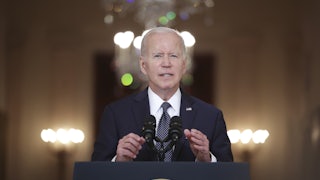If you spend much time examining the wreckage of America’s gun violence epidemic, you may eventually surrender to a feeling often categorized as numbness—not apathy, just a coping mechanism, a separation of yourself from the ongoing American tragedy. I’ve found the best way to beat back this sensation is to search for signs of hope in the wasteland. Here’s one such marker: In the 2020 federal spending bill, Congress allocated $25 million to the Centers for Disease Control and Prevention and the National Institutes of Health to study gun violence. It was the first time in over two decades that the CDC was given money to study the effects of gun violence on the public health.
The two-decade holdout was the result of the 1996 National Rifle Association–backed Dickey Amendment—a rider in the annual spending bill requiring that “none of the funds made available for injury prevention and control at the Centers for Disease Control and Prevention may be used to advocate or promote gun control.” That asinine piece of language, essentially mandating that experts in the field turn a blind eye to an ongoing calamity for purely ideological reasons, stands as a monument in the seemingly irresolvable public health crisis that is the gun violence epidemic.
It took 22 years—until the Appropriations Act of 2018—for Congress to clarify the Dickey Amendment with the following sentence: “While appropriations language prohibits the CDC and other agencies from using appropriated funding to advocate or promote gun control, the Secretary of Health and Human Services has stated the CDC has the authority to conduct research on the causes of gun violence.”
The fight simply to fund research on gun violence is instructive: The battle for sensible gun control is a long one. After the Sandy Hook shooting in 2012, President Obama issued a memo directing the CDC to “conduct research into the causes and prevention of gun violence.” He also called upon Congress to allocate $10 million to the agency for more research. But Obama’s gun-control push was ignored as we awoke to a chilling new reality: Even the mass murder of schoolchildren won’t motivate congressional Republicans to pass gun legislation. This may be a lesson we have to relearn every few years, as we did recently when Republicans belittled calls for gun legislation after the Uvalde, Texas, massacre, which left 19 schoolchildren dead.
But if you’re feeling that sense of numbing defeat creep in, here’s another marker of hope: In February 2022, the gun manufacturer Remington paid a settlement in the amount of $73 million in a lawsuit brought by nine families of Sandy Hook victims. After the settlement was announced, President Biden released a statement saying, “While this settlement does not erase the pain of that tragic day, it does begin the necessary work of holding gun manufacturers accountable for manufacturing weapons of war and irresponsibly marketing these firearms.”
Later in that same statement, Biden called upon Congress to repeal the Protection of Lawful Commerce in Arms Act, or PLCAA—the 2005 law shielding gun manufacturers and sellers from litigation. The law is a rare, broad immunity afforded to very few industries (vaccine manufacturers have a similar protection).
Repealing the PLCAA has been a wonky Democratic talking point for multiple cycles. In 2015, Hillary Clinton included repealing the Bush-era law in the list of gun reform measures she would take if elected president. Obviously, this never came to fruition—but again, this is another of the long battles. The fight for sensible gun legislation is a campaign of Napoleonic proportions. Much like Obama’s call for Congress to finance research on gun violence, it may be years before anybody acts upon Biden’s call to repeal the PLCAA.
But change has to start with those first fleeting steps. Biden’s suggestion that the “work of holding gun manufacturers accountable” is only beginning illustrates the exhausting length of this fight. Georgia State University College of Law professor Timothy Lytton, who authored the book Suing the Gun Industry, compares the current landscape of litigation against gun sellers and manufacturers to the early stages of litigation against the opioid industry. In a conversation with The New Republic, Lytton said that the litigatory front on the fight for gun control is “still at the beginning,” adding, “the comparison with the opioid litigation is very telling … it only gained traction over the course of two decades. We only find ourselves here because there’s two decades of filing of lawsuits, refining of theories, changing of public attitudes, debate about the role of the industry, increasing discovery documents; and all of those start to come together to create a more mature litigation phenomenon.”
Like the Dickey Amendment, the Protection of Lawful Commerce in Arms Act is an NRA-backed monument in the gun violence epidemic. After the PLCAA passed, NRA chief Wayne LaPierre praised it as a “historic piece of legislation.” He also championed the fact that 33 states had already passed similar laws granting immunity to gun manufacturers.
The year before the PLCAA was signed into law by President George W. Bush, the families of victims of John Allen Muhammad and Lee Boyd Malvo, who perpetrated the 2002 sniper attacks in the Washington, D.C. area, settled a case forcing the gun manufacturer Bushmaster to pay out $550,000. A lawyer for the families said at the time, “We view the settlement as a major breakthrough because it is the first time that a gun manufacturer has paid damages for negligence leading to the criminal use of a gun.” But a civil settlement is a step short of victory—it doesn’t affect jurisprudence in the same way a judge’s ruling would. Lytton notes that “prior to the passage of these immunity laws no plaintiff ever won any of these cases … so the gun industry basically never lost any of these suits, but they still wanted immunity from them.”
The language in the PLCAA is clear, stating that “businesses in the United States that are engaged in … the lawful design, manufacture, marketing, distribution, importation, or sale to the public of firearms … are not, and should not, be liable for the harm caused by those who criminally or unlawfully misuse firearm products or ammunition products that function as designed and intended.” But what is the “designed and intended” function of an AR-15-style rifle—a weapon that fires 45 rounds per minute—if not mass murder?
While the PLCAA aimed to be exhaustive, it does have a few exceptions. If, for example, a company manufactures a defective weapon, it isn’t protected by the PLCAA. The lawyer for the Sandy Hook families argued that Remington used marketing practices that ran afoul of Connecticut’s consumer law protections, which would have left it outside of PLCAA protections. Among those practices: preying on troubled young men with ads like the image of the assault rifle used to murder New England schoolchildren beside the slogan “CONSIDER YOUR MAN CARD REISSUED.”
Exploring and “opening up” the PLCAA exceptions is a new route with relatively little jurisprudence. Two states—New York and California—have recently passed laws that further clarify the PLCAA exceptions. New York’s law requires that “no gun industry member, by conduct either unlawful in itself or unreasonable under all the circumstances shall knowingly or recklessly create, maintain or contribute to a condition in New York state that endangers the safety or health of the public through the sale, manufacturing, importing or marketing of a qualified product.”
Similar legislation is being discussed in blue statehouses. Monisha Henley, senior director of state government affairs at Everytown for Gun Safety, told The New Republic, “We have been in conversations with a handful of other states” on state-level bills like those in New York and California.
While gun-control advocates are exploring potential weaknesses in the PLCAA, the judicial system has spent the past decade expanding upon the Second Amendment. The Supreme Court’s landmark 2008 ruling District of Columbia v. Heller divorced the right to bear arms from the “well-regulated militia” language in the Constitution. And the Supreme Court is currently looking at a challenge to a New York law regulating handguns—it’s expected to overturn New York’s law and deliver yet another victory to gun advocates. The Ninth Circuit—a traditionally liberal court before Trump remade the federal judiciary—recently struck down California’s attempt to ban assault weapons sales to people under 21 years old.
But the state-level legislation around the PLCAA is not a Second Amendment issue. Eric Ruben, law professor at SMU Dedman School of Law and a Brennan Center fellow specializing in the Second Amendment, told The New Republic, “These efforts to facilitate private lawsuits against the gun industry present fewer Second Amendment problems than direct government regulation of guns.” And the Supreme Court has been reluctant to weigh in on the PLCAA. In 2019, the court declined to hear Remington’s appeal, clearing the way for the Sandy Hook families’ lawsuit that ended in the $73 million settlement.
Here lies another marker of hope, a silver glimmer of sunshine before you trudge back into the wasteland-hellscape of the internet: Less than two weeks ago, a federal judge threw out a suit from gun industry groups seeking to challenge a New York law permitting “civil lawsuits against companies for conduct found to have endangered public safety.” And so the campaign for sensible gun control continues, on a new front but answering the same question America has been asking for decades: How do we escape the ongoing tragedy?










